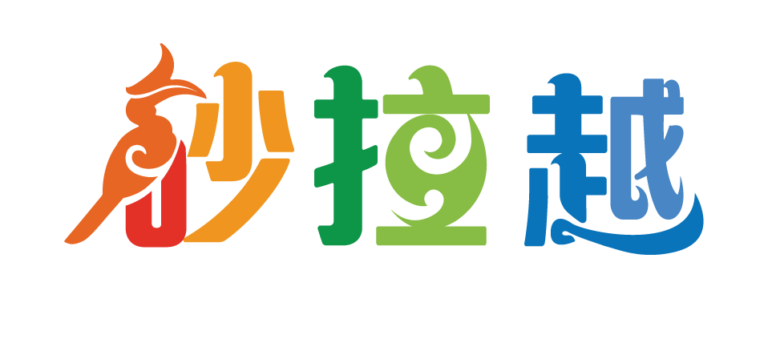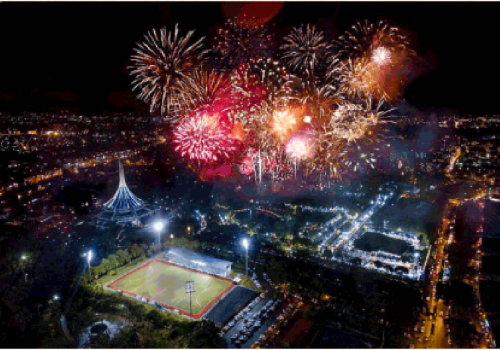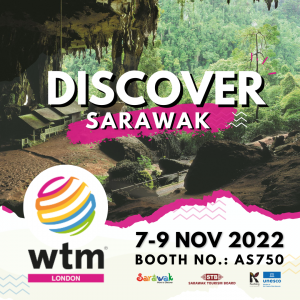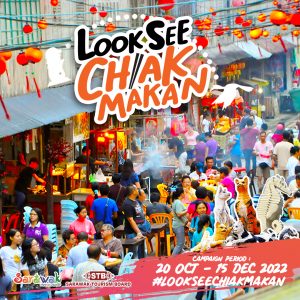Sarawak Textiles
Let the colours and motifs of Sarawak blow you away as you learn the cultural significance behind Sarawak textiles.
 (Image source: Ravindran John Smith) |
Sarawak’s pride and backbone is its united and diverse multiracial community. And with that, comes a myriad of cultural touchpoints, heritage and unique wonders—all waiting to be discovered. Lets dive deeper into Sarawak textiles – pua kumbu, keringkam and Sarawak Malay songket – and the stories behind these timeless threads.
Pua Kumbu
Kain pua kumbu is perhaps the most distinctive textile in Sarawak. Its origins can be traced back to the prehistoric Niah Caves 40,000 years ago.
 The spectacular scenery from inside Niah Caves. (Image source: Shutterstock) |
Essentially, kain pua kumbu is a wrap-patterned, ceremonial-woven textile associated with the Iban tribe. The designs are inspired by Iban deities and cosmology, tying back to the spirit world and its coexistence with humans in this realm. The process behind making these textiles tells the story of their cultural identity and is a rite of passage for Iban women. This unique talent of cloth weaving is passed down from the ancestors, ensuring a continuous legacy for the future generation.
 The intricate pua kumbu patterns and designs sprawled out artistically. (Image source: Shutterstock) |
Kain pua kumbu is made using the combination of backstrap loom weaving and ikat dyeing (which stands for tie-and-dye in Malay-Indo terminology). The fibres and dyes used in producing these textiles are sourced from the jungles of Borneo. They are derived from plants such as the rengat leaves, engkudu (Morinda citrifolia) and akar penawar landak.
 Local Iban women preparing the natural dye ingredient using a process called “ngar”. (Image source: Tanoti Crafts) |
The most valuable pua kumbu are those treated with the ritualised mordant dyeing process called “ngar”. This process is led by a master weaver and it encourages the gathering of other weavers to partake in a communal ritual. Today, this ritual is still observed by the community though the elements of traditional chants are omitted if the weavers are Christians.
Keringkam and Kain Songket Sarawak
For the Malay community, the keringkam and kain songket Sarawak both play an equally significant role in terms of culture and heritage.
 Women wear keringkam as part of their wedding veils. (Image source: Ameerul Roslan/@ameerullroslann) |
Keringkam, a gold thread embroidery, is recognised as a luxurious head covering or veil. In the olden days, keringkam was a status symbol of wealth and class. If a woman adorned it, she was from high society. Today, although more people can afford it, this piece of textile is considered a priceless heirloom in Malay families—and is normally reserved for special occasions such as weddings and formal gatherings.
 Women wear keringkam and kain songket as a Sarawakian regal outfit. (Image source: Nabil Jimi/@qoroi) |
Thin gold- or silver-plated threads bring the textile to life. The threads are woven onto sheer fabrics such as voile, kasa rubia cotton or silk organza using a flat needle. The painstaking process usually takes months to complete. This makes keringkam one of the most coveted accessories among Sarawakian Malay women. The ladies usually pair keringkam with kain songket Sarawak for a regal outfit that is simply stunning.
You can trace the origins of kain songket Sarawak back to the traders of the Malay archipelago. What sets it apart from other variations of songket is the weaving technique called tapok (hidden thread). Another interesting fact is that you can wear kain songket Sarawak inside out as the appearance and patterns on both sides of the textiles are exactly the same. The stylised patterns of floral motifs and symbols of animals depict nature which is abundant in Sarawak. Kain songket Sarawak is also worn by men as sampin, a piece of fabric wrapped around the waist over the baju Melayu.
 A baju Melayu without songket is very uncommon in Sarawak. (Image source: Amerull Roslan/@ameerullroslann) |
This is nowhere near a complete list of textiles exclusive to Sarawak. There are other pieces of cultural history to uncover but it is a great place to start nonetheless.
If you are looking to get a first-hand experience of where the first known kain pua kumbu is discovered, check out https://siasitoksarawak.rezgo.com/details/273291/niah-caves-national-park-day-trip Niah Caves National Park (Day Trip) package under Sia Sitok Sarawak. If you also want to pay a visit to the Textile Museum in Kuching, have a go at https://siasitoksarawak.rezgo.com/details/274380/best-of-kuching-bike-tour to check out the Best Of Kuching Bike Tour package where you get to spend a day in the city on wheels.
For more stories on Sarawak, click https://chinese.sarawaktourism.com/story/














